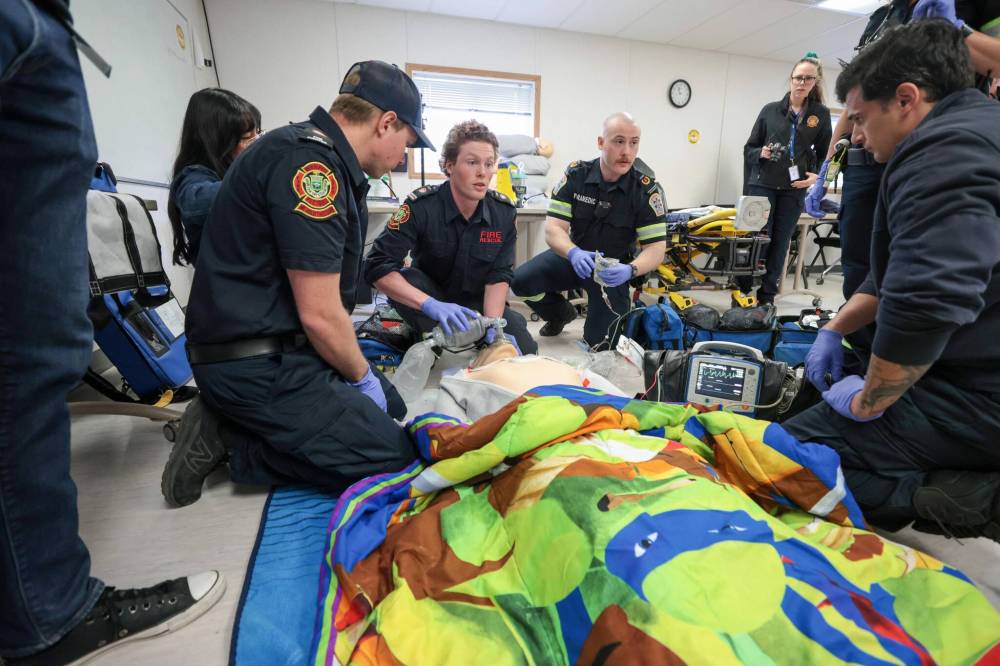Winnipeg paramedics have developed new methods of reaching vulnerable people as opioid overdoses and medical emergencies become more prevalent in the city.
Paramedics demonstrated their skills at the Winnipeg Fire and Paramedic Service Training Academy Wednesday in advance of national Paramedic Services Week, from May 19 to 25, with the theme of “help us help you.”
With the help of a talking mannequin, paramedics simulated a 911 call response for a cardiac arrest, demonstrated CPR protocol, held a session on how to administer naloxone, and allowed guests a peek in emergency vehicles.
WFPS deputy chief Ryan Sneath provided an update on the paramedicine program, which has expanded to include specialties in neonatal care, high-risk child birth, and advanced airway management for palliative patients.
About 90 of the city’s advanced care paramedics have completed training to provide pediatric dialysis in cardiac patients, he said.

RUTH BONNEVILLE / FREE PRESS
The Winnipeg Fire Paramedic Service goes through a mock demonstration on diagnosing STEMI heart attacks during a 911 cardiac arrest at the training academy Wednesday.
“Twenty-four hours a day, day in, day out, our paramedics show up at various roles within our city and do a difficult job that is focused on helping others,” he said.
The work of community paramedics, who offer medical care, home care referrals, senior care and other health needs to people on the streets and at home, can be as straightforward as distributing and administering naloxone or first aid on wounds, but sometimes is more nuanced.
Nathan Epp, an advanced care community paramedic, said he keeps a new smoke detector in his vehicle and will offer to install it if a homeowner needs one and doesn’t have the means to pay for it.
“We go to a lot of really rough environments, houses that are in bad shape, or people who are really struggling, (and) we just try to get supports in place,” he said Wednesday.
Recently, a growing part of the job has been to encourage people to keep naloxone kits on hand and learn how to use them.
“The reality is, we’re seeing opioid overdoses (on) every corner of the city, every socioeconomic demographic.”–Paramedic Chris Broughton
Community paramedic Chris Broughton, who offered naloxone training to observers, said there’s been an increase in cardiac arrests among young people as a result of opioid overdoses not treated with naloxone.
“We’re seeing far more cardiac arrests that we cannot get a pulse back, we cannot resolve that sudden death because it just took too long to get to that medication,” he said.
He described opiate addiction “as prevalent as allergies” and equally undeserving of negative stigma.
“The reality is, we’re seeing opioid overdoses (on) every corner of the city, every socioeconomic demographic,” he said. “It is truly a pandemic of its own.”
Mayor Scott Gillingham was among those who took in the demonstration. He said he’d like to see the community paramedic program grow.

RUTH BONNEVILLE / FREE PRESS
Mayor Scott Gillingham (left) learned how to perform CPR on a mannequin with WFPS deputy chief Ryan Sneath on Wednesday.
“I’m very open to seeing that program expanded, if it can be,” he said, “because we can work on prevention, it saves time, energy, it reduces the number of people who have to be transported to a hospital or to emergency room, and it saves the taxpayers (money) while providing really important medical service for the individual who needs it.”
Also discussed was programming that was introduced during the pandemic to try to mitigate long waits at hospitals: it has remained in effect because of its success. Launched in 2021, the emergency low-acuity triage program embeds paramedics into the 911 call centre and directs people to walk-in clinics and other resources, allowing for ambulances and hospital spots to be freed up.
Today, it’s estimated that one paramedic replaces the work of two ambulances through phone referrals that redirect patients, Broughton said.
“It was kind of right in the middle of that second, third wave of the pandemic that these programs were introduced. They’ve shown themselves so valuable and so effective that we can’t stop running these programs … It makes those scarce resources of ambulances more available to respond to emergencies in the community,” he said.
malak.abas@freepress.mb.ca
